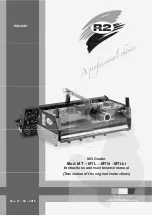
6
WARNING: Another form of anchorage connector MUST
always be used with the ladder bracket to safely secure the
unit to the anchorage of sufficient strength. The ladder
bracket should never be used alone to anchor a SafEscape
Device to a ladder.
Fig. 1b
Fig. 1c
4.2 Use
Once the SafEscape Device has been properly installed,
prepare the lifeline for use by lowering one end of the lifeline to
the ground or landing surface. Ensure that the lifeline is free of
knots or kinks.
IMPORTANT: A full-body harness must be used with the
SafEscape Rescue/Descent Device.
Controlling Descent
Descent may be controlled by a person located at the base of
the descent (where the SafEscape Device is installed) OR by
the descender so long as the free lifeline end has not already
passed above the descender.
To slow or interrupt descent:
Firmly grasp the free end of the
lifeline (see Fig. 2a). For increased leverage, pass the free end
of the lifeline end through the pigtail (see Fig. 2b).
To suspend descent and free hands for rescue:
Firmly grasp
the free end of the lifeline, pass it through the pigtail, and then
secure in the cam cleats (see Fig. 2c). This procedure locks the
lifeline in place to prevent unintentional descent, while freeing
the rescuer hands.
Fig. 2a
Fig. 2b
Fig. 2c
Single Person Descent
1. Connect the carabiner on the lifeline end to the front or
back D-ring of the full-body harness.
[Be sure to read, understand and follow all instructions and warnings
provided with the full-body harness at the time of shipment.]
2. Prior to descent, remove any slack in the lifeline that may
exist between the user and the device. Once the lifeline is
taut, maintain a secure hold on the free end of the lifeline
(see Fig. 3).
3. To begin descent, release the free end of the lifeline.
Descent speed is automatically controlled via the
SafEscape's centrifugal brake.


































